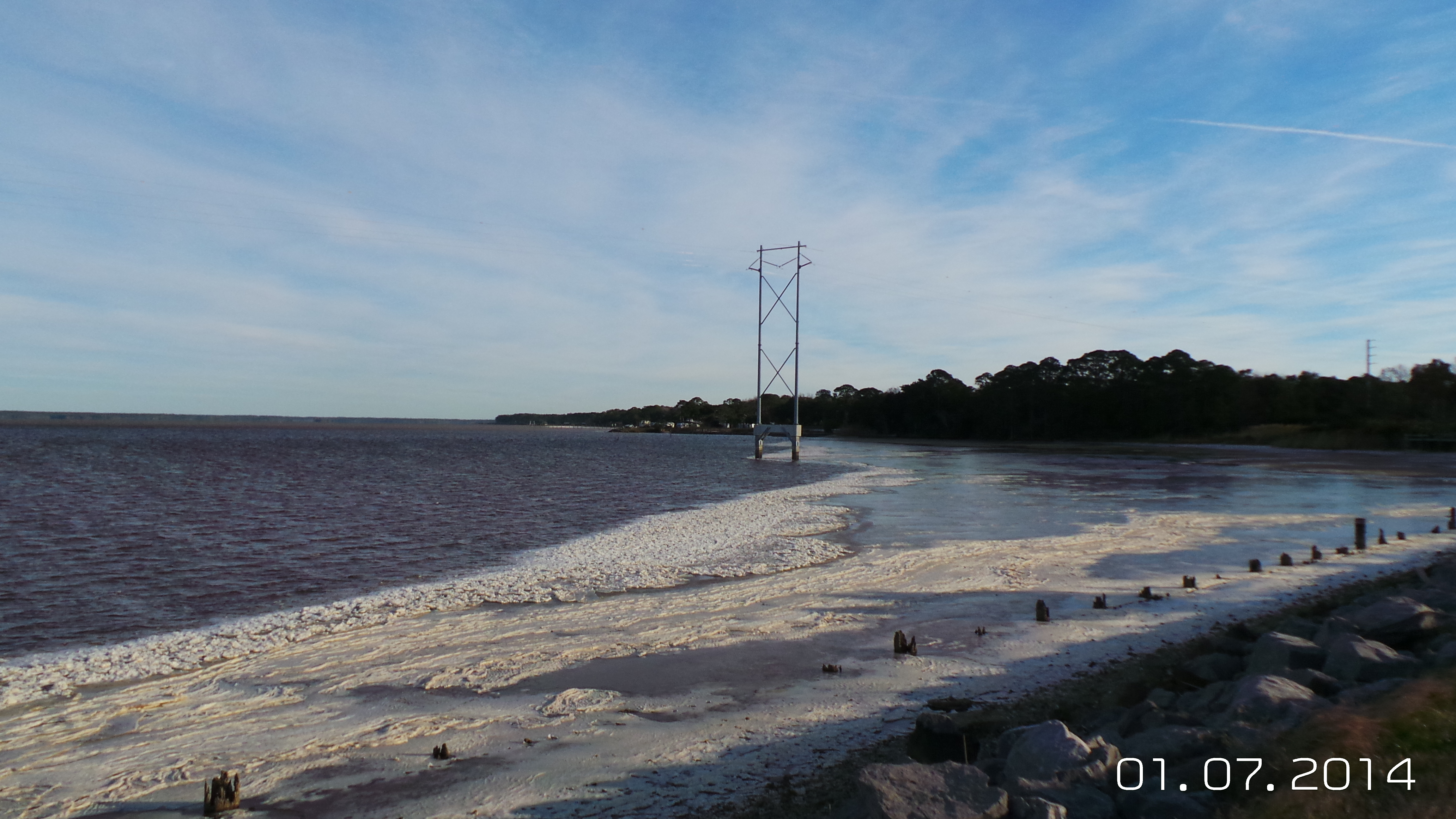
by Chris Verlinde | Jan 25, 2014
With the ongoing cold weather across the Panhandle, fish kills are being reported in many areas.
In the Panhandle, average water temperatures have dropped down to the 50s (degrees Fahrenheit) in many waterbodies. This is about ten degrees cooler than in normal years. Fish have a tolerance to temperature but when air and water temperatures decrease rapidly, fish kills may occur.
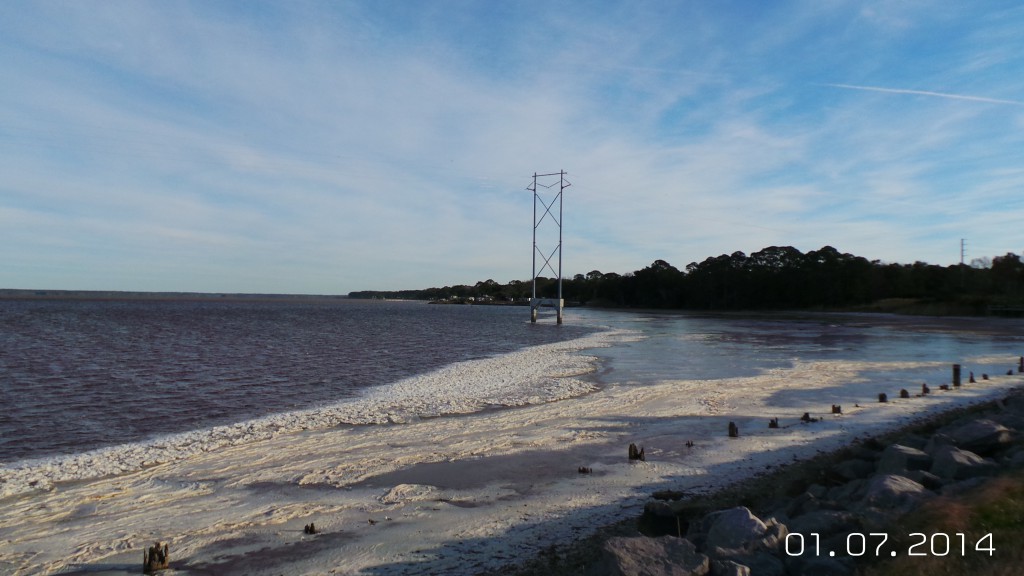
Recent ice coverage in Apalachicola Bay is visible example of the harsh environmental conditions that have led to reported fish kills throughout Florida, including the Panhandle. Photo by L. Scott Jackson
Fish kills due to cold weather are naturally occurring phenomena. In some cases there may be an ecological benefit. Exotic fish species that have adapted to Florida’s subtropical climate may not be able to withstand these colder temperatures and large numbers of the populations may be eliminated. The decrease in the population of exotic species may allow for an increase in native populations.
The Florida Fish and Wildlife Conservation Commission’s (FWC) Fish Kill Hotline provides maps of fish kills throughout the state on a monthly basis. If you see a fish kill you can report it by phone: 1-800-636-0511 or online.
The FWC Fish Kill Website also allows the user to report fish kills and search the current database for fish kills by dates, county and possible causes of fish kills. (See example search below)
Your search was:
- From 12/01/2013
- To 01/24/2014
- All Counties
- Suspected Causes Cold Weather
Note: Select an Asterisked (*) Column Heading to Sort by That Column
| *ID |
Report
Number |
*Date
Reported |
City |
*County |
Call
Category |
*Probable
Cause |
Water
Body Name |
Specimen
Count |
| Comments |
| 20048 |
122013 |
12/20/2013 |
Lakeland |
Polk |
Fish Kill |
Cold Weather |
N Pkwy Frontage Rd & Carabbean Rd |
100s |
| Species Unidentified |
| 20051 |
122713 |
12/27/2013 |
Treasure Island |
Pinellas |
Mortality – Mollusca |
Cold Weather |
West Gulf Blvd |
100s |
| Conch |
| 20057 |
010214 |
1/2/2014 |
North Port |
Sarasota |
Fish Kill |
Cold Weather |
El Prada West |
100s |
| Sucker Mouth Catfish |
| 20064 |
010814 |
1/8/2014 |
Tarpon Springs |
Pinellas |
Mortality – Cartilaginous |
Cold Weather |
Anclote River Boat Ramp |
100s |
| Hammerhead Shark, Jack Crevalle, Pompano, Permit |
| 20065 |
010814 |
1/8/2014 |
Panacea |
Wakula |
Fish Kill |
Cold Weather |
Lake Tucker / Alligator Point |
100s |
| Trout, Sheepshead |
| 20067 |
011014 |
1/10/2014 |
Fort Walton Beach |
Okaloosa |
Fish Kill |
Cold Weather |
Cinco Bayou |
100s |
| Species Unidentified, Silverback, Yellow Bellie |
| 20068 |
011214 |
1/12/2014 |
Palm Harbor |
Pinellas |
Fish Kill |
Cold Weather |
Anclote – Between Marker 32 & 36 |
Unknown Count |
| Unknown Count |
| 20069 |
011214 |
1/12/2014 |
Tarpon Springs |
Pinellas |
Fish Kill |
Cold Weather |
Anclote – N Pointe Alexis Dr |
Unknown Count |
| Jack Crevalle, Permit |
| 20070 |
011214 |
1/12/2014 |
Lecanto |
Citrus |
Fish Kill |
Cold Weather |
Creek Off Pirates Cove |
10 |
| Snook |
| 20071 |
011314 |
1/13/2014 |
New Port Richey |
Pinellas |
Fish Kill |
Cold Weather |
1/4 Mile S Anclote Key |
100s |
| Jack Crevalle, Trout |
| 20073 |
011314 |
1/13/2014 |
Crystal River |
Pasco |
Fish Kill |
Cold Weather |
East of Power Plant |
Unknown Count |
| Jack Crevalle, Pompano |
| 20085 |
011814 |
1/18/2014 |
Pensacola |
Escambia |
Fish Kill |
Cold Weather |
Heron Villa Lane – Perdido Bay |
100 |
| Species Unidentified |
| 20090 |
012114 |
1/21/2014 |
Pensacola |
Escambia |
Fish Kill |
Cold Weather |
Riola Lane/Perdido Bay |
Unknown Count |
| Species Unidentified |
|

Above is an example of the December 2013 reported fish kill map:
There are a number of reasons for fish kills besides cold temperatures; low dissolved oxygen levels, spawning fatalities, diseases and parasites, algae blooms and human induced fish kills.
To report a fish kill to the FWC Fish Kill hotline, you will need information such as the name of the water body, whether the water is fresh, brackish or saltwater, observations of the characteristics of the water, species and number of fish that are observed (if you don’t know the species, you can check unknown), condition of the fish and if there are any abnormalities such as lesions, etc. on the fish.
If there are too many fish to count, estimate the total number by counting how many fish are in a 10’ x 10’ area, then estimate the total area that fish are present (along the shoreline and out into the water). Estimate how many 10’ x 10’ areas would fit into the total area, and multiply that number by the number of fish in the original 10’ x 10’ area. This will give you an estimate of the total number of fish.
Make a note of the weather conditions the past few days, air temperature, rainfall, cloud cover, wind strength and directions. Talk to your neighbors to determine if they have noticed anything unusual about the waterbody in the last few days.
For more information on understanding and reporting fish kills check out this publication from the University of Florida IFAS Extension:
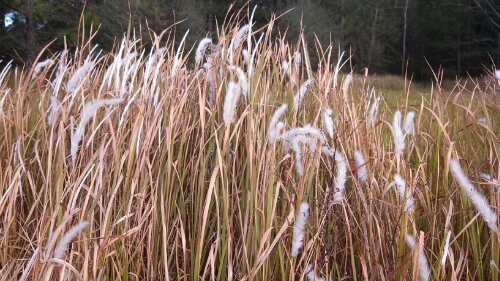
by Jennifer Bearden | Jan 3, 2014

Join us for a workshop on the biology and control of cogongrass.
January 14, 2014
Registration begins at 8:30am (Eastern Time)
Program starts at 9:00am (Eastern Time) and will end at 4:30pm (Eastern Time).
The cost of the workshop is $25 and includes lunch.
Locations:
Pensacola, Fl
Crestview, Fl
Chipley, Fl
Tallahassee, Fl

Please remember to specify which locations when calling to register and purchase the correct location ticket when registering online.
Pesticide CEUs have been requested. We are awaiting final approval and will update this post as soon as we have additional information. If you have questions please contact us at 850-606-5200.
AGENDA
Cogongrass in the Panhandle Workshop
9:00 – 9:50 AM – Overview, Biology and Control of Cogongrass – Dr Greg MacDonald, UF-IFAS Agronomy – Participants will learn what we currently know about the biology and control of cogongrass.
9:50 – 10:40 AM – “Safely Applying Right of Way Herbicides” – Jennifer Bearden & Sheila Dunning, UF-IFAS Extension Okaloosa County – Participants will learn pathways of herbicide efficacy, safety, label-reading, and PPE for common Right of Way Herbicides.
11:00-11:50 AM – Update: “Cogongrass Control in ROW, Forestry and Natural Areas – New Research, New Programs” – Participants will learn herbicide selections, application rates, timing and methods of control being researched and employed in the Southeast.
11:00 – 11:25 AM – “Imazapyr and Glyphosate Application Rate, Timing, and Methods for Cogongrass Control” – Dr Pat Minogue, UF-IFAS/NFREC Forestry
11:25 – 11:50 AM – “USFS/Five-State Forestry Agency Cogongrass Initiative” – Dr Jeff Eickwort, FDACS-Florida Forest Service
11:50 AM – 12:40 PM – “Cooperative Invasive Species Management in the Panhandle”
11:50 – 12:10 – “Breaking down Artificial Barriers to Allow Everyone to Cooperate” –
Brian Pelc, Natural Areas Restoration Specialist with The Nature Conservancy, and Invasive Species Coordinator for the Apalachicola National Forest, USFS
12:10 – 12:25 – A Regional Case Study from the Apalachicola CISMA (Cooperative Invasive Species Management Area) – Brian Pelc, Natural Areas Restoration Specialist with The Nature Conservancy and Invasive Species Coordinator for the Apalachicola National Forest, USFS
12:25 – 12:40 – A Regional Case Study from the Six Rivers CISMA – Brooke Saari, Sea Grant Extension Agent, UF/IFAS Extension in Okaloosa and Walton counties
12:40 – 1:30 PM – Lunch (catered-in at each host site)
1:30 – 2:30 PM – “Tools for Identifying, Tracking and Managing Cogongrass across the Landscape” – Participants will learn to use technologies available to identify, track and manage cogongrass infestations.
1:30 – 2:00 PM – “Monitoring Cogongrass Infestations with EDDMapS” – Jed Dillard, UFIFAS Extension Jefferson County
2:00 – 2:30 PM – “A Local Case Study from the City of Tallahassee”– Tony Murray, Coordinator of Environmental Regulation Compliance with City of Tallahassee Environmental Policy and Energy Resources/ Policy & Program Development
The following topics will be covered by Extension faculty at each site.
Okaloosa – Jennifer Bearden and Sheila Dunning
Washington – Mark Mauldin and Josh Thompson
Leon – Will Sheftall and Stan Rosenthal
Jefferson – Jed Dillard
2:30 – 2:55 PM – Cogongrass and Look-alikes ID – Participants will learn how to identify Cogongrass and some similar plants.
3:00 – 3:25 PM – Label Reading Exercise – Participants will learn to read herbicide labels and why it is important.
3:30 – 3:55 PM – Sprayer Calibration – Participants will learn methods to calibrate ATV and Backpack sprayer equipment.
4:00 – 4:25 PM – Personal Protective Equipment – Participants will learn proper equipment and why it is important.
4:25-4:30 PM – Evaluation
by | Jan 3, 2014
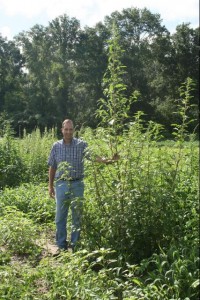
Palmer amaranth can reach heights up 10 feet and signal real trouble for hunters, farmers, and land managers. Loaded with numerous small seeds, mature plants and “offspring” are difficult to control. Photo Courtesy of University of Florida / IFAS
Deer feeders are common in North Florida, and “deer corn” is sold in multiple markets. Cross-roads convenience stores sell it in plain brown bags and big box stores in town sell it in camouflage bags with three color pictures of giant bucks on the front. With the high price of corn in 2012, many hunters saved a few dollars buying “combine run” corn from local farmers or corn screenings from grain elevators. The corn’s no different, however, either product can contain weed seed, especially Palmer amaranth. These weeds can mean big trouble for farmers and hunters.
Palmer amaranth is a species of pig weed, but it’s not your granddaddy’s “careless weed”. It’s taller than either red root pigweed or spiny pigweed, and is becoming resistant to several herbicides, most notably glyphosate (“Roundup”). Amaranth seed are small and plentiful (1 to 1.5 millimeters in diameter) and easily can fit in the nooks and crannies of grain harvesting and handling equipment.
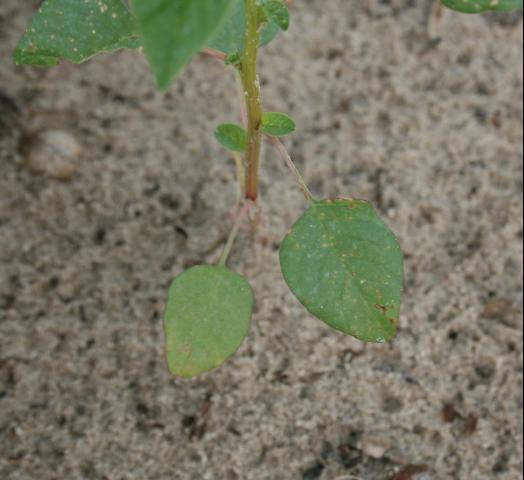
Palmer amaranth first true leaves have small notches on the end and can serve as an identifying characteristic. Photo Courtesy of University of Florida / IFAS.
Once Palmer amaranth seed make it into a deer feeder, there’s a huge opportunity for seedlings to take root in places under the radar of typical scouting and control measures. If these seedlings are herbicide resistant, you’ve done far more harm to the landowner than any savings on corn cost can offset. Conservative estimates indicate herbicide costs have at least doubled due to herbicide resistant weeds. Do your local farmer a real favor; scout and control weeds coming from your deer feeder.
Further information on identifying and controlling Palmer amaranth is available from your county Extension agent or at http://edis.ifas.ufl.edu/ag346
Feeding corn to deer and turkey is permitted by the Florida Fish and Wildlife Conservation Commission as long as the following restrictions are met. “Resident game and wild hogs may be hunted in proximity of year-round game-feeding stations on private lands, provided the feeding station has been maintained with feed for at least six months prior to taking resident game,” and “Wild turkey may not be taken if the hunter is less than 100 yards from a game feeding station when feed is present.” See General Information regarding Feeding Game at http://myfwc.com/hunting/regulations/general-information

by Rick O'Connor | Nov 22, 2013
It seems everyone in the Panhandle is talking about the invasive lionfish. This non-native member of the scorpionfish family was first seen in U.S. waters in 1989 near Ft. Lauderdale. Over the last two decades, much has been learned about the biology and potential impacts of lionfish in our waters; For additional background information you can read more at these websites http://myfwc.com/wildlifehabitats/nonnatives/marine-species/lionfish and http://escambia.ifas.ufl.edu/marine/2012/08/17/the-invasion-of-the-lionfish
This past October, the Florida Fish and Wildlife Conservation Commission held the first state lionfish summit in Cocoa Beach. Researchers, fishery managers, divers, fishermen, and the general public received research updates, discussed current issues, and provided input regarding future management needs. Here are a few of the interesting highlights from the summit.
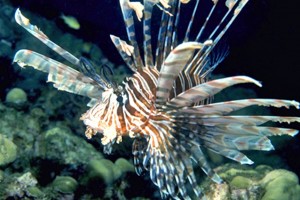
Red Lionfish
Photo: Florida Sea Grant
What are the potential problems?
- Several theories on how lionfish were initial released into state waters have been suggested. However, research results now indicate a single introduction of lionfish in Florida initiated the invasion into the Western Atlantic presumably from just a few aquarium specimens.
- Sixty-thousand lionfish continue to be imported into the state each year.
- Compared to native Pacific population, Florida densities of lionfish are much higher; 400 fish/hectare in Florida compared to 80 fish/hectare in the Pacific. On average, invasive Atlantic Lionfish individuals are larger than the native populations in the Pacific basin.
- Studies from Pensacola showed that lionfish population has doubled annually since 2010 and lionfish densities are highest on artificial reefs.
- Invasive lionfish have no natural predators and may spawn 30,000 – 40,000 eggs every 2 to 4 days.
- Another potential problem reported are records of lionfish entering the Loxahatchee and Indian Rivers; indicating that they are able to move into brackish water.
What are the negative impacts?
Young lionfish feed primarily on crustaceans and when they are older they prey on reef fish. Research and stomach analysis indicate 70 different reef fish species as potential prey. Lobster fishermen in the Keys found lionfish are the leading by-catch species and have reduced lobster harvest by as much as 50%. Another study indicates lionfish on natural reefs they prefer blennies. However, on artificial reefs they feed on small snappers, sea bass, and groupers. Finally, an interesting study compared primary reef predators. Reefs with only grouper there was a 36% decrease of juvenile fish while reefs with lionfish the decrease was 94%.
What can be done?
Several reports indicate that collecting tournaments are effective; Lad Akins of Reef Environmental Education Foundation (www.reef.org) reported a 69% reduction of lionfish from one event in Key Largo. Another study had similar results but indicated that some spear fishermen were more successful than others, suggesting training may be required to increase efficiency.
Other reports indicate that work where native fish were introduced and conditioned to consume lionfish have led these native predators to follow and even bite divers thinking that “free food” may be available; it was suggested that this idea not be pursued.
Locally, lionfish rodeos sponsored by Emerald Coast Reef Association occur frequently in Okaloosa County. Escambia County Marine Resources hosted a pilot event this summer. Escambia will begin a full lionfish control program in 2014. If you have questions or comments, please contact your local UF/IFAS natural resource or Sea Grant Extension Agent.
Please note: UF/IFAS and Florida Sea Grant does not organize volunteers to participate in local lionfish control events; this is done by independent community groups. UF/IFAS and Florida Sea Grant provides this information about food safety concerns associated with eating lionfish. Click here for more information.
by Rick O'Connor | Jul 20, 2013
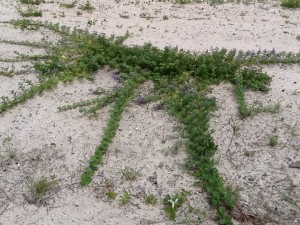
Beach vitex expands its woody rhizomes aggressively; it can actually grow over sidewalks and driveways.
It’s actually a pretty plant, this Beach Vitex (Vitex rotundifolia), and it is very good at stabilizing eroding dunes. In the 1990’s, the state of South Carolina planted this shrub to help restore dunes lost during hurricanes. It was selected because of salt tolerance, production of woody rhizomes (runners) that extend over 60 feet to trap sand, and the beautiful purple flowers that attract beneficial insects; it seemed perfect! However, folks along the Atlantic coast had no idea how invasive it would become a few years later. Residents discovered that it chokes out many of the native species such as sea rocket and sea oats producing an area of only this plant.
It is now causing problems for sea turtles. As you can see in some of these photos, the plant grows over the fore-dune, blocking access for nesting. Beach Vitex grows so aggressively that during the 60 day incubation time many turtle nests are overgrown, entrapping the hatchlings. Some have been found dead, entangled within the rhizome mats. The Beach Vitex “invasion” has become so bad that South Carolina developed a Vitex Task Force to deal with the problem.
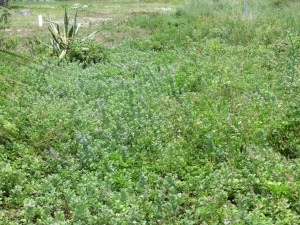
This yard on Pensacola Beach has become overrun by vitex.
Is this a problem for Florida?
According to the records the Early Detection and Distribution Mapping System EDDmaps.com, Beach Vitex is distributed northward to the Chesapeake Bay area and south to Jacksonville. It is found in coastal Alabama and there is one record of the plant in Escambia County.
With so few records in Florida it is not currently listed as an invasive species in our state and there is no program set up to control it. However the Sea Grant Extension Agent in Escambia County, Rick O’Connor, was alerted in 2013 that vitex was in Gulf Breeze, Florida (Santa Rosa County) and possibly on Santa Rosa Island (Escambia County).

Please circulate to area residents to provide visual identification of Beach Vitex. Contact your Extension Office for control options and help reduce it’s impact on native species.
A “Wanted Poster” was developed by O’Connor to post in the coastal communities of Escambia and Santa Rosa counties to see if the plant was more common than the records indicated. At this time, six properties on Santa Rosa Island have confirmed records of Vitex and two more will be surveyed soon. The wanted poster program was published in the local newspaper which reached the east coast of Florida. Reports from that coast indicate that it has extended south into Volusia County. Okaloosa/Walton Sea Grant Agent Brooke Saari is posting the wanted poster in those counties to see if the plant has reached their coasts.
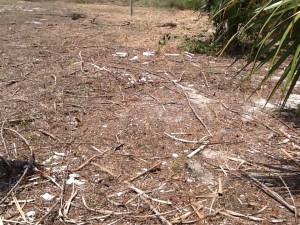
The owner of this yard mowed the vitex. However the woody rhizomes are still present. They will need to either dig this up or use multiple chemical applications to completely remove.
Anyone along the coast of the Florida Panhandle who feels they may have this plant can contact either Rick O’Connor (850-475-5230; roc1@ufl.edu) or Brooke Saari (850-689-5850; bsaari@ufl.edu) and we can confirm identification. The plant is not currently listed as invasive in our state and removal is not required. However, based on the experience in the Carolina’s and other invasive species, if you wish to eradicate this plant doing so early is important. It is much less labor intensive and less costly when there are few plants. If you do choose to remove it please contact your local Extension office first. We can provide methods of successful removal. We would also like to photograph and log the record on EDDmaps.
Editor’s note: Rick provided all the photos in this article.
by Judy Biss | Jul 6, 2013
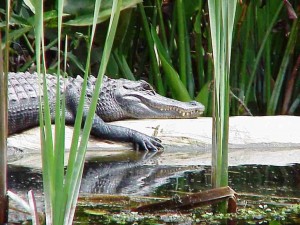
Summer is a time to bask in the sunshine for many of Florida’s wildlife species.
Each of Florida’s seasons are characterized by a variety of amazing and beautiful wildlife activities. Below is a list of some notable native wildlife behaviors occurring in July and August around the state.
July
Birds
- Shorebird migration starts in mid-July, peaking in August.
- Swallow-tailed kites begin gathering as do purple martins and tree swallows in preparation for migrating south for the winter.
- Look out for nesting shorebirds, and keep your vehicles and dogs from disturbing them.
Reptiles
- Later this month, young alligators and crocodiles will begin to hatch.
Mammals
- Baby raccoons, foxes, armadillos, possums, and bobcats leave dens and begin following parents.
Plants
- Sea oats flower along the Atlantic and Gulf.
- Scrub morning glory and butterfly weed begin to bloom.
Of Special Historical Note:
August
Birds
- First flocks of blue-winged and green-winged teal arrive to winter on Florida lakes and wetlands.
- Yellow warbler migration begins.
Mammals
- Two-year old black bear cubs will wean from their mothers.
- Short-tailed shrews will begin a second round of breeding for the year.
Reptiles
- Young sea turtles are hatching so avoid marked sea turtle nests and turn off lights to reduce light pollution.
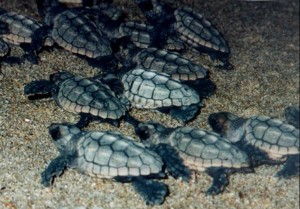
Sea turtle hatchlings are attracted to light sources on their dash to the ocean. Summer hatching means lights out for sea turtles! photo by L Avens 2003
Insects
- Thousands of great southern white butterflies can be seen migrating through coastal areas.
Invertebrates
- Corals along the Keys spawn at the full moon
More of these “happenings” for the calendar year can be found at the University of Florida’s Wildlife Extension Website: Wildlife Happenings.
Also at the Wildlife Extension website are a number of interesting resources to learn not only about our native wildlife, but our non-native/invasive wildlife as well. For example: can you distinguish between the invasive Cuban treefrog and our native species? The Cuban treefrog is well established in central and south Florida and has been documented in Bay and Leon Counties in north Florida. Be on the lookout for this alien treefrog!

Natural habitats invaded by Cuban Treefrogs include pine forests, hardwood hammocks, and swamps. In urban and suburban settings they are most commonly found on and around homes and buildings, and in gardens and landscape plants – Image by Dr. Steve A Johnson 2005.
On the flip side, did you know that our “own” American Bullfrog is invasive in other countries throughout the world? Also, current research is investigating the observations that mating calls of some non-native frogs may interfere with the dynamics of native frogs’ calling behavior. These and other up-to-date facts can be found in the UF/IFAS Invader Updater newsletter. The current issue has articles on the suckermouth catfish, Cuban treefrog, lampreys, and the recent record-sized python caught in south Florida.
Focusing back to our own unique native wildlife, you may find, as I did, this UF website of Frogs & Toads of Florida of interest to you. It has beautiful pictures of each species as well as an audio recording of its distinctive call. So, turn up the volume on your speakers and listen to a sampling of the chorus that serenades Floridians each night. Click Here to listen to the call of the Squirrel Treefrog.
















